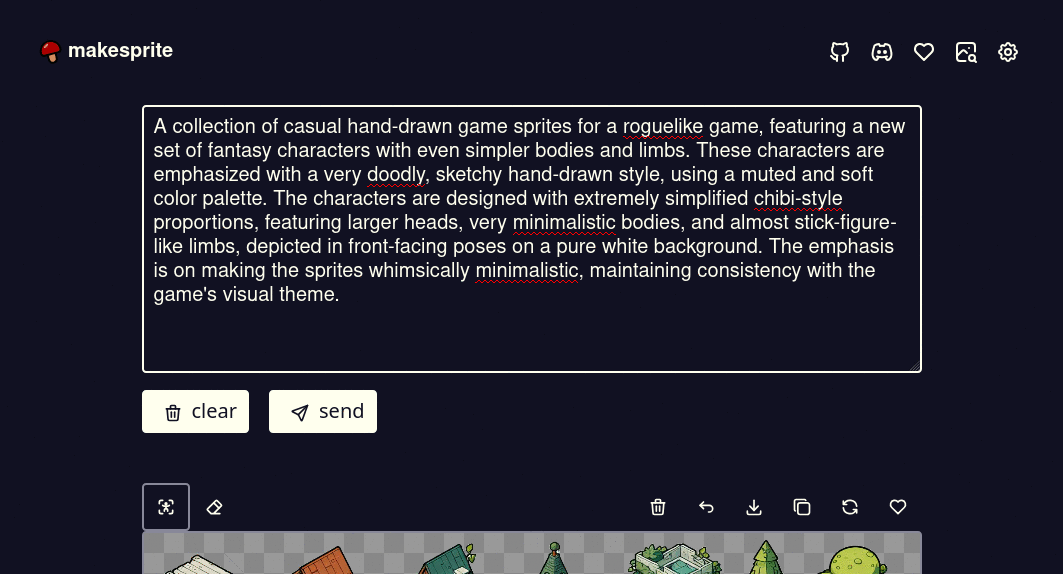makesprite.com is a simple open-source online app I made for generating sprites for games.

The first time you open the app it downloads a set of default prompts and sprite sheets. These are a useful starting point for generating your own. You can click the "Re-run prompt" button and the prompt that was used to generate that spritesheet will be loaded. You can also use the "Copy prompt" button if you want to use it elsewhere. Before you can run a prompt you'll need to go to the settings page and enter an OpenAI key since the app uses the OpenAI API to generate the images. Click "Send" to send the prompt to the API and after a while you will receive a spritesheet back.
This post is available as a video on YouTube:
Once you get the spritesheet it will be stored locally in your browser. You can then tweak the image by using the fill tool to remove any unwanted background colors. Once you find sprites you like you can use the "extract sprite" mode. This will copy the sprite to your clipboard as well as providing an interface to download it. You can also favourite, download, or revert spritesheets to their original form if you make a mistake when removing background.
Makesprite uses OpenAI's DALL-E to generate the images and comes with a bunch of user-interface enhancements to make it easy to organize and extract game sprites. It is a 100% client-side browser app and nothing is stored on the server side. Because it relies on DALL-E for the image generation you'll need an OpenAI key to use it. Future versions may integrate other image generators.
Makesprite doesn't do anything you can't do directly with DALL-E. You can use DALL-E directly with the same prompts. However it does enhance the experience of the sprite-generation workflow specifically:
- It provides a series of curated prompts that are the best I could come up with for generating sheets of sprites.
- It provides an interface for removing the background and extracting individual sprite elements. In my experience it is time consuming and fiddly to do this with e.g. Gimp or Photoshop.
- It keeps your generated sprite sheets together and visible in one place rather than spread throughout your other sessions in the ChatGPT interface.
- You can create template prompts with variables that can be modified between runs.
- You can re-use prompts easily and copy them to your clipboard.
Limitations
The sprites generated by DALL-E are limited. They aren't animated. They are pixel based not vector based and aren't always cleanly separated from the background. They suffer the usual gen-AI issues with missing/extra limbs, elements that make no sense, bad reflections, weird shapes and shadows, etc. It is difficult to get any consistency between different generated sprite sheets. DALL-E is really bad at creating pixel art so I've focused on non-pixel-art prompts. Sometimes DALL-E throws things in that have nothing to do with the prompt. Finally, just like Copilot and ChatGPT, DALL-E is probably trained on non-public-domain and sometimes copyright data, and that might pose ethical or legal problems.
All that said, I think these sprites will be good enough for some use-cases.
If you're making a simple game with limited animations, and if consistency doesn't matter that much, or you only need a small number of specific sprites, or if you're only looking for simple flat token images, then makesprite might fit the bill. If you just need placeholder graphics to give your demo or gamejam game the right look or feel it might be good enough. I think makesprite could be great for gamejams where you just need something fast that fits the theme.
If you generate something that is good enough for placeholder graphics you could also take it to a real game artist once your game is ready, and pay them to create real game art using the makesprite output as a reference or inspiration. I'd be really happy if more work for real artists was an outcome from tools like this.
About the tech
I had heaps of fun building this app with ClojureScript. I've built a lot of small web apps with Reagent and CloureScript now and the workflow has only got better. At around 1000 lines of code and 21 days of part time dev this is probably one of the fastest apps I've built. I chose to deploy it to GitHub pages instead of going my usual route of deploying with Piku. As a predominantly front-end app hosting it on GitHub should make it faster due to their CDN.
This was fun to make. I hope you find it useful. Enjoy!

